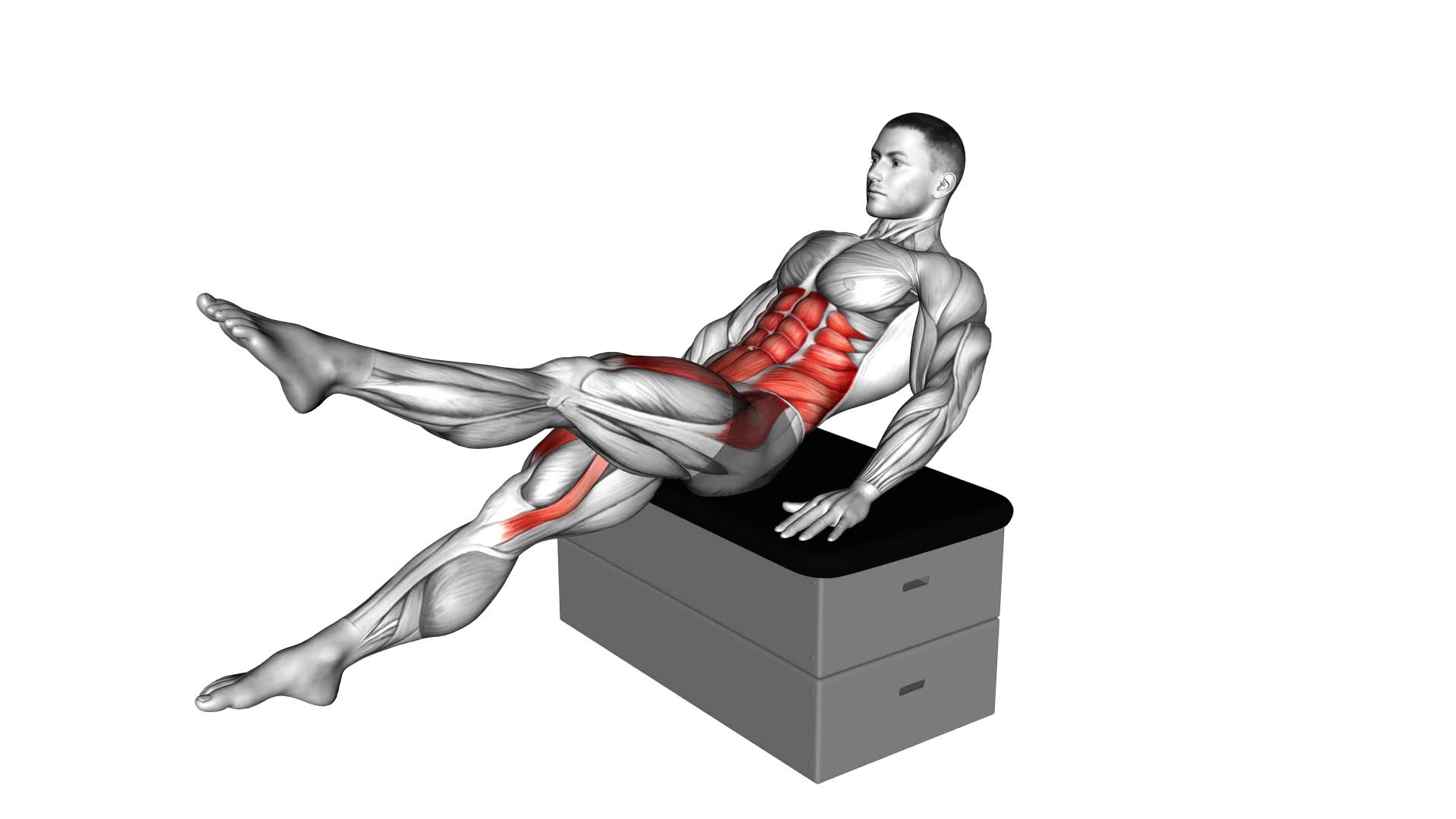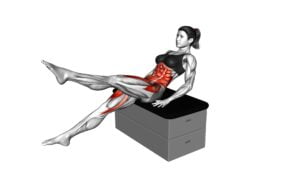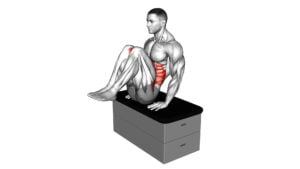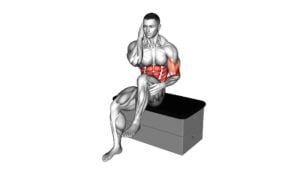Sitting Flutter Kick on a Padded Stool – Video Exercise Guide & Tips

Get ready to strengthen your core and lower body with the Sitting Flutter Kick on a Padded Stool! This exercise is perfect for anyone looking to target their abs and legs.
Watch This Exercise Video
In this video guide, we'll show you the proper form and technique, equipment needed, common mistakes to avoid, and tips for maximizing your results.
Whether you're a beginner or advanced, this exercise can be modified to suit your fitness level.
Let's dive in and start kicking!
Key Takeaways
- Sitting flutter kick improves core strength and flexibility.
- It targets abdominal muscles, lower back, and hip flexors.
- Proper form and technique are crucial for maximizing results and avoiding common mistakes.
- Consistency, progression, and variation are key for long-term improvements in endurance, strength, and overall fitness.
Benefits of Sitting Flutter Kick
To experience the benefits of sitting flutter kick, you can expect improved core strength and increased flexibility. This exercise targets your abdominal muscles, lower back, and hip flexors, making it an effective way to strengthen your core. By sitting on a padded stool and kicking your legs in a fluttering motion, you engage your abdominal muscles to stabilize your body, leading to improved core strength. The continuous kicking motion also works your hip flexors, improving their flexibility and range of motion.
In addition to improved core strength and flexibility, sitting flutter kick can also help increase your endurance. The repetitive movement of kicking your legs for an extended period of time challenges your cardiovascular system, making it more efficient and resilient. This can lead to increased endurance and stamina, allowing you to perform physical activities for longer periods without feeling fatigued.
To maximize the benefits of sitting flutter kick, it's important to maintain proper form and technique. Keep your back straight, engage your core muscles, and focus on the kicking motion from your hips. Gradually increase the duration and intensity of your flutter kicks as your strength and endurance improve. Remember to listen to your body and stop if you experience any pain or discomfort.
With consistent practice, sitting flutter kick can help you achieve a stronger core, improved flexibility, and increased endurance.
Proper Form and Technique
To maintain proper form and technique while performing sitting flutter kick on a padded stool, you should focus on engaging your core muscles and keeping your back straight. This will help you maximize the benefits of the exercise and avoid common mistakes that can lead to injury or ineffective workouts.
One common mistake to watch out for is hunching your back. This can put unnecessary strain on your lower back and diminish the effectiveness of the exercise. Instead, keep your back straight throughout the movement, maintaining a neutral spine position.
Another technique modification you can make is to ensure that your core muscles are engaged. This means actively contracting your abdominal muscles to stabilize your torso. By doing so, you won't only protect your lower back but also increase the intensity of the exercise.
Additionally, pay attention to the speed and range of motion of your kicks. It's important to maintain control and avoid swinging your legs too forcefully. Start with small, controlled kicks and gradually increase the range of motion as you become more comfortable and stronger.
Equipment Needed for the Exercise
Now let's talk about the equipment you'll need for the Sitting Flutter Kick exercise.
The first thing you'll need is a padded stool or chair to sit on. This will provide support and stability during the exercise. If you're on a budget, there are cost-effective options available that can still get the job done.
And if you don't have access to a padded stool, there are alternatives you can try to replicate the exercise.
Essential Exercise Equipment
You'll need a padded stool for the sitting flutter kick exercise.
Before starting any exercise, it's important to warm up properly. A proper warm-up helps to increase blood flow to the muscles, improve flexibility, and reduce the risk of injury. To warm up, you can do some light cardio exercises like jogging or jumping jacks, followed by dynamic stretches targeting the muscles you'll be using during the exercise.
Choosing the right exercise mat is also crucial for your comfort and safety. Look for a mat that provides enough cushioning to support your body weight and reduce pressure on your joints. It should also have a non-slip surface to prevent any accidents during the exercise. Consider the thickness and durability of the mat as well. A thicker mat can provide more comfort, especially if you have sensitive knees or joints. Lastly, make sure to clean and maintain your exercise mat regularly to keep it in good condition.
Cost-Effective Equipment Options
For the sitting flutter kick exercise, you'll need a cost-effective option for equipment. Luckily, there are several affordable alternatives to choose from.
One option is to use a yoga mat or towel instead of a padded stool. These items can provide cushioning and support for your lower back while you perform the exercise.
Another cost-effective option is to use a stability ball. These balls are relatively inexpensive and can be used for a variety of exercises, including the sitting flutter kick. They provide an unstable surface, which can help engage your core muscles even more during the exercise.
With these cost-effective options, you can still get a great workout without breaking the bank.
Now, let's explore some alternatives to expensive equipment.
Alternatives to Expensive Equipment?
To explore cost-effective alternatives for the sitting flutter kick exercise, consider equipment options that won't break the bank. Instead of investing in expensive equipment, there are affordable alternatives and DIY options available.
For instance, you can use a sturdy chair with a padded seat as a substitute for a padded stool. This will provide the necessary support and comfort for your exercise.
Additionally, if you don't have access to ankle weights, you can use household items such as water bottles or cans as makeshift weights. Simply fill them with water or sand to add resistance to your flutter kicks.
Common Mistakes to Avoid
To avoid common mistakes while performing the sitting flutter kick on a padded stool, make sure that you maintain proper form and engage your core muscles throughout the exercise. This will help you maximize the results of this workout and prevent any potential injuries.
One common mistake to avoid is letting your feet touch the ground during the exercise. It's important to keep your legs extended and elevated off the ground, as this engages your abdominal muscles and challenges your core strength.
Additionally, avoid using momentum to swing your legs, as this takes away from the effectiveness of the exercise. Instead, focus on controlled movements and keep your legs straight and together throughout the exercise.
Another mistake to avoid is arching your lower back or hunching your shoulders. This can strain your back and neck muscles and take away from the targeted benefits of the exercise. Instead, maintain a neutral spine position by keeping your back straight and your shoulders relaxed.
Tips for Maximizing Results
To maximize your results while performing the sitting flutter kick on a padded stool, focus on maintaining proper form and engaging your core muscles throughout the exercise. Here are some tips to help you get the most out of this workout:
- Maintain proper posture: Sit up tall with your back straight and shoulders relaxed. This will help you engage your core and prevent strain on your lower back.
- Keep your abs tight: Throughout the exercise, make sure to keep your abdominal muscles engaged. This won't only help you maintain good form but also maximize the benefits for your core muscles.
- Breathe effectively: Practice deep and controlled breathing during the exercise. Inhale deeply through your nose and exhale fully through your mouth. This will help you maximize your endurance and oxygen intake.
- Gradually increase intensity: Start with a comfortable pace and gradually increase the speed and intensity of your kicks. This will challenge your muscles and help you build endurance over time.
Variations and Progressions
Now let's explore some variations and progressions for the sitting flutter kick exercise. These options will increase the difficulty level and challenge your muscles even more.
If you're a beginner, don't worry! There are also technique modifications that can help you build strength and improve your form.
Progressing through different variations not only keeps your workouts interesting, but it also allows you to reap the benefits of targeting different muscle groups and improving overall fitness.
Increased Difficulty Options
You can challenge yourself further by exploring various variations and progressions in the sitting flutter kick exercise on a padded stool. Here are four options to increase the difficulty of this exercise:
- Alternatives to traditional flutter kick: Instead of performing the standard flutter kick, try variations such as scissor kicks or bicycle kicks to engage different muscle groups and increase the intensity.
- Adding resistance: Attach ankle weights or resistance bands to your ankles to add resistance and make the exercise more challenging for your lower body muscles.
- Increasing speed: Speed up the movement of your legs during the flutter kick to increase the cardiovascular benefits and enhance the overall intensity of the exercise.
- Modifications for individuals with limited mobility: If you have limited mobility or difficulty balancing on a padded stool, you can perform the sitting flutter kick while seated on a regular chair or stability ball.
By incorporating these variations and progressions, you can take your sitting flutter kick exercise to the next level.
Now let's move on to the next section about technique modifications for beginners.
Technique Modifications for Beginners
Beginners can modify their technique for the sitting flutter kick exercise by starting with a slower and controlled movement. This allows you to focus on maintaining proper form and engaging the correct muscles.
One common mistake to avoid is kicking too fast, which can lead to a loss of control and ineffective muscle activation.
Another modification for beginners is to perform the exercise with bent knees instead of straight legs. This reduces the demand on the hip flexors and makes it easier to maintain balance.
By starting with these modifications, you can build a strong foundation and gradually progress to more challenging variations.
Now let's explore the benefits of progressing variations to further enhance your sitting flutter kick exercise.
Benefits of Progressing Variations
To further enhance your sitting flutter kick exercise, progressing variations can provide additional benefits and challenges. By incorporating technique modifications and advancing the difficulty level, you can maximize the effectiveness of this exercise. Here are four key benefits of progressing variations:
- Increased muscular endurance: As you modify the technique and add more challenging movements, your muscles will work harder and become more resilient over time.
- Improved core strength: Progressing variations require greater engagement of the core muscles, leading to a stronger and more stable midsection.
- Enhanced coordination and balance: By introducing different movements and positions, progressing variations challenge your coordination and balance, improving your overall body control.
- Heightened cardiovascular fitness: As you increase the intensity and speed of your flutter kicks, your heart rate rises, providing a great cardiovascular workout.
Frequently Asked Questions
How Many Calories Can You Burn by Doing Sitting Flutter Kick on a Padded Stool?
You can burn calories by doing sitting flutter kicks on a padded stool.
The benefits of this exercise include strengthening your core muscles and improving your balance.
By engaging your legs and core, you can increase your heart rate and burn calories.
Sitting flutter kicks are a low-impact exercise that can be done by anyone, making it a convenient option for those with limited mobility.
Can Sitting Flutter Kick on a Padded Stool Help to Strengthen Your Core Muscles?
Sitting flutter kick on a padded stool is a great sitting exercise that can help strengthen your core muscles. By engaging your abdominal muscles, this exercise targets your core and promotes stability.
The fluttering motion also activates your hip flexors and lower abs, providing a comprehensive core workout. Incorporating this exercise into your routine can improve your balance, posture, and overall core strength.
Is It Necessary to Use a Padded Stool for Sitting Flutter Kick, or Can Any Sturdy Stool Be Used?
To answer your question, using a padded stool for sitting flutter kicks isn't necessary, but it does have its benefits.
While any sturdy stool can be used as an alternative seating option, a padded stool provides extra comfort and support, allowing you to focus on engaging your core muscles without discomfort.
Additionally, the padding helps to reduce stress on your lower back and tailbone, making the exercise more enjoyable and effective.
Can Sitting Flutter Kick on a Padded Stool Help to Improve Your Flexibility?
Sitting flutter kick on a padded stool can definitely help improve your flexibility. By engaging your core muscles and maintaining balance on the stool, you're able to focus on the movement of your legs, leading to increased leg strength.
The padded surface also provides comfort and support, allowing you to perform the exercise with proper form and technique. Incorporating this exercise into your routine can be a great way to enhance your flexibility and overall fitness level.
Are There Any Modifications or Alternative Exercises for Individuals With Knee or Back Pain?
If you're dealing with knee pain, there are modifications you can make to the sitting flutter kick exercise. For example, you could try reducing the range of motion or using a lower stool.
As for back pain, there are alternative exercises that can help. You might consider exercises like bird dogs or cat-cow stretches, which can strengthen your core and improve flexibility without putting too much strain on your back.
Conclusion
Incorporating the sitting flutter kick exercise into your routine can provide numerous benefits. This exercise is known for strengthening your core, improving your balance, and increasing flexibility in your lower body.
To maximize the effectiveness of the sitting flutter kick, it is important to maintain proper form and avoid common mistakes. This includes keeping your back straight, engaging your abdominal muscles, and focusing on controlled movements.
Starting with the appropriate equipment, such as a yoga mat or a stability ball, can help provide support and stability during the exercise. Additionally, considering trying variations and progressions of the sitting flutter kick can challenge yourself further and target different muscle groups.
Dedication and consistency are key when it comes to seeing results from this simple yet effective exercise. By incorporating the sitting flutter kick into your routine and staying committed, you can achieve great results and improve your overall fitness level.

Author
Years ago, the spark of my life’s passion ignited in my mind the moment I stepped into the local gym for the first time. The inaugural bead of perspiration, the initial endeavor, the very first surge of endorphins, and a sense of pride that washed over me post-workout marked the beginning of my deep-seated interest in strength sports, fitness, and sports nutrition. This very curiosity blossomed rapidly into a profound fascination, propelling me to earn a Master’s degree in Physical Education from the Academy of Physical Education in Krakow, followed by a Sports Manager diploma from the Jagiellonian University. My journey of growth led me to gain more specialized qualifications, such as being a certified personal trainer with a focus on sports dietetics, a lifeguard, and an instructor for wellness and corrective gymnastics. Theoretical knowledge paired seamlessly with practical experience, reinforcing my belief that the transformation of individuals under my guidance was also a reflection of my personal growth. This belief holds true even today. Each day, I strive to push the boundaries and explore new realms. These realms gently elevate me to greater heights. The unique combination of passion for my field and the continuous quest for growth fuels my drive to break new ground.



